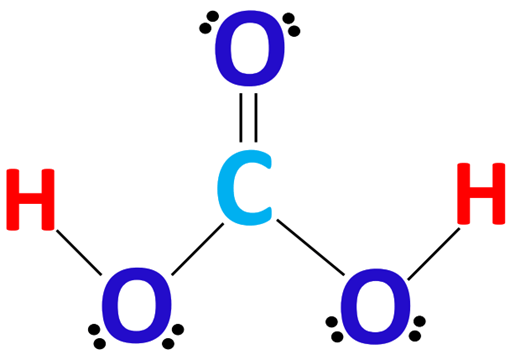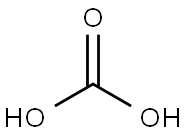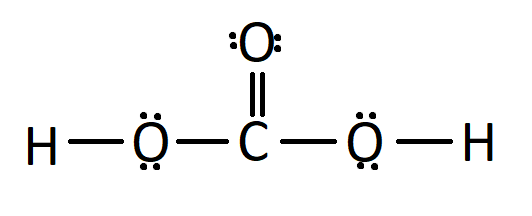How the CH2O3 lewis structure is formed
Lewis structure of CH2O3
The Lewis structure of carbonic acid(CH2O3) is made up of one carbon (C) atom, three oxygen (O) atoms and two hydrogen (H) atoms. Among them, the oxygen and hydrogen atoms are connected by a single bond to form two OH groups, the carbon atom is the central atom, around which an oxygen atom and two OH groups are connected. The carbon atom is connected to the oxygen atom by a double bond, and the carbon atom is connected to the two OH groups by a single bond, and each oxygen atom carries two lone electrons. The structure is shown below:

Steps for drawing the CH2O3 Lewis structure
Step 1 Calculate the number of valence electrons for C, O and H
According to the ordering of the elements in the periodic table, we can get that the C, H and O atoms are located in the 14th, 1st and 16th group of elements in the periodic table, so the valence electrons in the C, H and O atoms are 4, 6 and 1, respectively. Therefore, the total number of valence electrons in the molecule of CH2O3 = valence electrons of 1 carbon atom + valence electrons of 3 oxygen atoms + valence electrons of 2 hydrogen atoms = 4 + 6(3) +1(2 ) = 24.
Step 2 Identify the central atom
The central atom must have the smallest electronegativity, this is because the atom with the smallest electronegativity needs to share its electrons with the surrounding atoms and always puts hydrogen on the outside if it is present in a given molecule. So, for a carbonic acid molecule, carbon has a lower electronegativity than oxygen and hydrogen, hence carbon is the central atom and oxygen and hydrogen are the outer atoms.
Step 3 Labelling the electron lone pairs between atoms
Total valance electrons pairs = σ bonds + π bonds + lone pairs at valence shells, total electron pairs are determined by dividing the number total valence electrons by two. For, CH2O3 molecule, Total number of pairs of electrons are 12.
The carbon atom is connected to one oxygen atom and two OH groups by a σ-bond, and the two OH groups are also connected to each other by a σ-bond (one σ-bond is equal to one electron pair). The remaining seven pairs of electrons are distributed as follows: three pairs of electrons on one oxygen atom, and two pairs of electrons on each of the remaining two oxygen atoms on the OH groups.
Step 4 Stability of structure and minimize charges on atoms by converting lone pairs to bonds
When there are positive and negative charges on lot of atoms or higher charges (like +2, +3, -2, -3) on atoms in an ion or molecule, that structure is not stable. Therefore, We should try to reduce charges on atoms if it is a possible.
In order to check the stability of the central carbon (C) atom we must check that it is forming an octet, if it does not have an octet then the lone pair of electrons will move to form a double or triple bond, in order for this carbon atom to be stable the electron pairs must be moved away from the outer oxygen atom so that the carbon atom can have eight electrons (i.e. an octet). After the move, one oxygen atom forms a double bond with the carbon atom, and the other two OH groups remain attached to the carbon atom, ending up with two lone pairs of electrons on each of the three oxygen atoms. See the diagram below:





